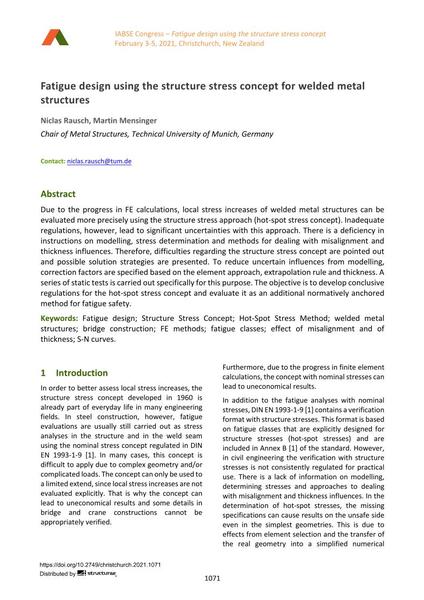Fatigue design using the structure stress concept for welded metal structures

|
|
|||||||||||
Bibliografische Angaben
| Autor(en): |
Niclas Rausch
(Chair of Metal Structures, Technical University of Munich, Germany)
Martin Mensinger (Chair of Metal Structures, Technical University of Munich, Germany) |
||||
|---|---|---|---|---|---|
| Medium: | Tagungsbeitrag | ||||
| Sprache(n): | Englisch | ||||
| Tagung: | IABSE Congress: Resilient technologies for sustainable infrastructure, Christchurch, New Zealand, 3-5 February 2021 | ||||
| Veröffentlicht in: | IABSE Congress Christchurch 2020 | ||||
|
|||||
| Seite(n): | 1071-1078 | ||||
| Anzahl der Seiten (im PDF): | 8 | ||||
| DOI: | 10.2749/christchurch.2021.1071 | ||||
| Abstrakt: |
Due to the progress in FE calculations, local stress increases of welded metal structures can be evaluated more precisely using the structure stress approach (hot-spot stress concept). Inadequate regulations, however, lead to significant uncertainties with this approach. There is a deficiency in instructions on modelling, stress determination and methods for dealing with misalignment and thickness influences. Therefore, difficulties regarding the structure stress concept are pointed out and possible solution strategies are presented. To reduce uncertain influences from modelling, correction factors are specified based on the element approach, extrapolation rule and thickness. A series of static tests is carried out specifically for this purpose. The objective is to develop conclusive regulations for the hot-spot stress concept and evaluate it as an additional normatively anchored method for fatigue safety. |
||||
| Stichwörter: |
Wöhlerlinien Ermüdungsbemessung Brückenbau
|
||||
